
The longhorn beetles (Cerambycidae), also known as long-horned or longicorns, are a large family of beetles, with over 35,000 species described.

Dermestidae are a family of Coleoptera that are commonly referred to as skin beetles. Other common names include larder beetle, hide or leather beetles, carpet beetles, and khapra beetles. There are over 1,800 species described.
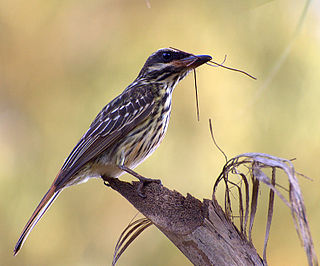
The streaked flycatcher is a passerine bird in the tyrant flycatcher family.
Francis Polkinghorne Pascoe was an English entomologist mainly interested in beetles.

The Rosalia longicorn or Alpine longhorn beetle, is a large longicorn that is distinguished by its distinctive markings.

Cerambyx cerdo, commonly known as the great capricorn beetle or cerambyx longicorn, is a species of beetle in family Cerambycidae. It occurs in North Africa, Europe, and Asia.
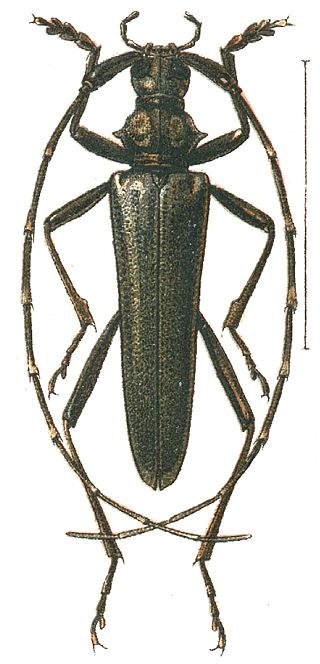
The Disteniidae are a small family of beetles in the superfamily Chrysomeloidea, traditionally treated as a group within the Cerambycidae.

Dermestes maculatus is a species of beetle with a worldwide distribution, being present on all continents except Antarctica. In Europe, it is present in all countries.

The longicorn beetle Phoracantha obscura is a species of beetle native to Australia.

Callosobruchus maculatus is a species of beetles known commonly as the cowpea weevil or cowpea seed beetle. It is a member of the leaf beetle family, Chrysomelidae, and not a true weevil. This common pest of stored legumes has a cosmopolitan distribution, occurring on every continent except Antarctica. The beetle most likely originated in West Africa and moved around the globe with the trade of legumes and other crops. As only a small number of individuals were likely present in legumes carried by people to distant places, the populations that have invaded various parts of the globe have likely gone through multiple bottlenecks. Despite these bottlenecks and the subsequent rounds of inbreeding, these populations persist. This ability to withstand a high degree of inbreeding has likely contributed to this species’ prevalence as a pest.

The Decora longicorn beetle is an Australian species of the family Cerambycidae.

Retrachydes thoracicus is a species of beetle in the family Cerambycidae, the only species in the genus Retrachydes.
Arhopaloscelis is a genus of longhorn beetles of the subfamily Lamiinae, containing the following species:

Cervoglenea lata is a species of beetle in the family Cerambycidae, and the only species in the genus Cervoglenea. It was described as ? Glenea lata by J.L. Gressitt in 1935, from a specimen taken in Taiwan. He later placed it in a separate genus Cervoglenea.

Callosobruchus chinensis, also known as the adzuki bean weevil, pulse beetle, Chinese bruchid or cowpea bruchid, is a common species of beetle found in the bean weevil subfamily. Although it is commonly known as the adzuki bean weevil, it is in fact not a true weevil, belonging instead to the leaf beetle family, Chrysomelidae.
Acridocephala is a genus of longhorn beetles of the subfamily Lamiinae, and the sole member of the tribe Acridocephalini, which was described by Dillon and Dillon in 1959. The genus is greatly divergent of the other Lamiini tribes of Ethiopia. The back of members heads and thoraxes and the elytra, unlike these other tribes, lie in a single plane. The front of these beetles are very narrowed forms a sharp angle with the vertex. Antenna tubercles are erect and do not diverge.
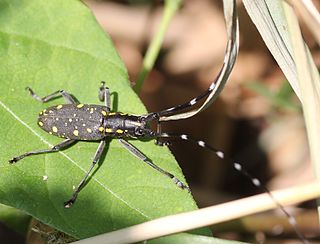
Psacothea hilaris, the yellow spotted longicorn beetle, is a species of beetle in the family Cerambycidae. It was described by Francis Polkinghorne Pascoe in 1857. It is known from North Korea, China and Japan. It has been introduced to Italy.
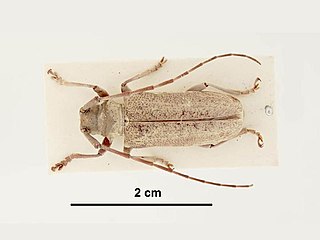
Acalolepta vastator is a species of beetle in the family Cerambycidae. It was described by Newman in 1841, originally under the genus Monohammus. Breuning erroneously synonymised this species with Acalolepta mixta. It is found throughout eastern Australia, including Tasmania and South Australia, as well as parts of South Asia. The Australian government recognize this species as a pest species. It feeds on grape vine, papaya and curtain fig tree.
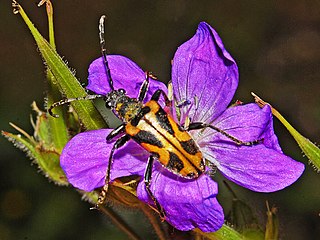
Brachyta is a genus of the Lepturinae subfamily in long-horned beetle family.
Zoodes maculatus is a species of Longhorn beetle native to Sri Lanka and India.
















